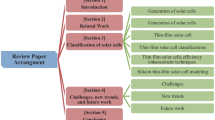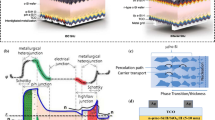Abstract
The specific contact resistance of the screen-printed Ag contacts in the silicon solar cells has been investigated by applying two independent test methodologies such as three-point probe (TPP) and well-known transfer length model (TLM) test structure respectively. This paper presents some comparative results obtained with these two measurement techniques for the screen-printed Ag contacts formed on the porous silicon antireflection coating (ARC) in the crystalline silicon solar cells. The contact structure consists of thick-film Ag metal contacts patterned on the top of the etched porous silicon surface. Five different contact formation temperatures ranging from 725 to 825 °C for few minutes in air ambient followed by a short time annealing step at about 450 °C in nitrogen ambient was applied to the test samples in order to study the specific contact resistance of the screen-printed Ag metal contact structure. The specific contact resistance of the Ag metal contacts extracted based on the TPP as well as TLM test methodologies has been compared and verified. It shows that the extraction procedure based on the TPP method results in specific contact resistance, ρ c = 2.15 × 10−6 Ω-cm2 indicating that screen-printed Ag contacts has excellent ohmic properties whereas in the case of TLM method, the best value of the specific contact resistance was found to be about ρ c = 8.34 × 10−5 Ω-cm2. These results indicate that the ρ c value extracted for the screen-printed Ag contacts by TPP method is one order of magnitude lower than that of the corresponding value of the ρ c extracted by TLM method. The advantages and limitations of each of these techniques for quantitatively evaluating the specific contact resistance of the screen-printed Ag contacts are also discussed.












Similar content being viewed by others
Notes
The front contact paste is a mixture of Ag with various organic binders and additives to ensure a better adhesion of the sintered contacts with Si surface. The lead borosilicate glass frit is commonly used in the commercial Ag metal paste plays an important role in the contact formation and helps to achieve the adhesion of the Ag paste to Si surface after the initial firing step [14]. The glass frit in its molten state is highly reactive; it wets and effectively etches the heavily doped silicon surface and modifies the sheet resistance underneath the metal contact.
References
P.N. Vinod, J. Mater. Sci.: Mater. Electron. 18, 805–810 (2007)
P. Doshi, J. Meija, K. Tate, A. Rohatgi, IEEE Trans. Electron Dev. ED-44(9), 1417–1423 (1997)
P.N. Vinod, Solid State Commun. 149, 957–961 (2009)
D.K. Schroder, D.L. Meier, IEEE Trans. Electron Dev. 31, 631–637 (1984)
P.N. Vinod, J. Mater. Sci.: Mater. Electron. 19, 594–601 (2008)
S.M. Sze, Physics of the semiconductor devices (Wiley, New York, 1982)
H.H. Berger, J. Electrochem. Soc. 119, 507–514 (1972)
W. Shockley, Report No. A1-TOR-64-207 (September 1964, Air Force Atomic Laboratory, Wright-Patterson Air Force Base, OH, USA)
G.K. Reeves, H.B. Harrison, IEEE Trans. Electron Dev. Lett. EDL-3, 111–113 (1982)
S.J. Proctor, L.W. Lindholm, IEEE Trans. Electron Dev. Lett. EDL-3, 294–296 (1982)
J. Chen, W.L. Oldham, IEEE Trans. Electron Dev. Lett. EDL-5, 178–180 (1984)
M. Melczarsky, G. Gallego Garcia, N.E. Posthuma, E. Van Kerschaver, G. Beaucarne, in Proceedings of the 35th IEEE Photovoltaic Specialists Conference (PVSC) Philadelphia, PA, 2009, 960–963
P.N. Vinod, B.C. Chakravarty, R. Kumar, M. Lal, S.N. Singh, Semicond. Sci. Technol. 15, 286–290 (2000)
P.N. Vinod, Semicond. Sci. Technol. 20, 966–971 (2005)
H.H. Berger, Solid State Electron. 15, 145–158 (1972)
D.K. Schroder, Semiconductor Material and Device Characterization, 2nd edn. (Wiley, New York, 1998)
P.N. Vinod, J. Mater. Sci.: Mater. Electron. 21, 730–736 (2010)
P.N. Vinod, M. Lal, J. Mater. Sci.: Mater. Electron. 16, 1–6 (2005)
P.N. Vinod, in Proceedings of the 34th IEEE Photovoltaic Specialists Conference (PVSC), 2009, 1341–1434
P.N. Vinod, J. Alloy. Compd. 470, 393–396 (2009)
W.D. Kingery, J. Appl. Phys. 30, 301–312 (1959)
C. Ballif, D.M. Huljic, G. Willeke, A. Hessler-Wyser, Appl. Phys. Lett. 82, 1878–1880 (2003)
Y.S. Chung, H.G. Kim, IEEE Trans. Compon. Hybrids Manuf. Technol. 11, 195–199 (1988)
P.N. Vinod, in Proceedings of the 33rd IEEE Photovoltaic Specialist Conference (PVSC), San Diego, CA (11–16 May 2008) 1–5
International Technology Roadmap for Semiconductors (ITRS), http://public.itrs.net (2007)
A. Mette, D. Pysch, G. Emanuel, D. Erath, R. Preu, S.W. Glunz, Prog. Photovolt. Res. Appl. 15, 493–505 (2007)
M. Horties, S.W. Glunz, Prog. Photovolt. Res. Appl. 16, 555–560 (2007)
S.P. Zimin, V.S. Kuznetsova, A.V. Prokaznikov, Appl. Surf. Sci. 91, 355–358 (1995)
C.Y. Chang, Y.K. Feng, S.M. Sze, Solid-State Electron. 14, 541–554 (1971)
C.M. Osborn, K.B. Bellur, Thin Solid Films 332, 428–436 (1998)
A.C.Y. Yu, Solid State Electron. 13, 239–245 (1970)
F.A. Podovani, R. Stratton, Solid State Electron. 9, 965–976 (1966)
Author information
Authors and Affiliations
Corresponding author
Rights and permissions
About this article
Cite this article
Vinod, P.N. Specific contact resistance measurements of the screen-printed Ag thick film contacts in the silicon solar cells by three-point probe methodology and TLM method. J Mater Sci: Mater Electron 22, 1248–1257 (2011). https://doi.org/10.1007/s10854-011-0295-z
Received:
Accepted:
Published:
Issue Date:
DOI: https://doi.org/10.1007/s10854-011-0295-z




